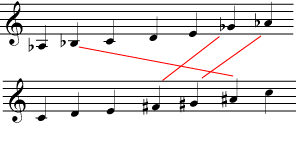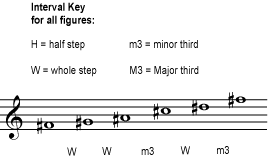| << Chapter < Page | Chapter >> Page > |

In a whole tone scale , every interval is a whole step . In both the chromatic and the whole tone scales, all the intervals are the same. This results in scales that have no tonal center ; no note feels more or less important than the others. Because of this, most traditional and popular Western music uses major or minor scales rather than the chromatic or whole tone scales. But composers who don't want their music to have a tonal center (for example, many composers of "modern classical" music) often use these scales. Listen to a whole tone scale .

There is basically only one chromatic scale; you can start it on any note, but the pitches will end up being the same as the pitches in any other chromatic scale. There are basically two possible whole tone scales. Beginning on a b, write a whole tone scale that uses a different pitches than the one in [link] . If you need staff paper, you can download this PDF file .

Now write a whole tone scale beginning on an a flat. Is this scale essentially the same as the one in [link] or the one in [link] ?

Assuming that octaves don't matter - as they usually don't in Western music theory, this scale shares all of its possible pitches with the scale in [link] .
In Western music, there are twelve pitches within each octave . (The thirteenth note starts the next octave.) But in a tonal piece of music only seven of these notes, the seven notes of a major or minor scale, are used often.
In a pentatonic scale , only five of the possible pitches within an octave are used. (So the scale will repeat starting at the sixth tone.) The most familiar pentatonic scales are used in much of the music of eastern Asia. You may be familiar with the scale in [link] as the scale that is produced when you play all the "black keys" on a piano keyboard.

Listen to the black key pentatonic scale . Like other scales, this pentatonic scale is transposable ; you can move the entire scale up or down by a half step or a major third or any interval you like. The scale will sound higher or lower, but other than that it will sound the same, because the pattern of intervals between the notes (half steps, whole steps, and minor thirds) is the same. (For more on intervals, see Half Steps and Whole Steps and Interval . For more on patterns of intervals within scales, see Major Scales and Minor Scales .) Now listen to a transposed pentatonic scale .

Notification Switch
Would you like to follow the 'Understanding basic music theory' conversation and receive update notifications?